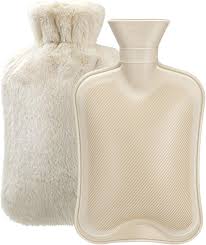
Hot water bottles have been a household staple for centuries, providing warmth and soothing relief for a variety of aches, pains, and ailments. This simple, yet effective tool offers a natural, drug-free way to combat discomfort, particularly when it comes to muscle soreness, menstrual cramps, and cold weather. Here’s an in-depth look at the benefits, types, and uses of hot water bottles, along with some safety tips for optimal comfort and effectiveness.
1. Benefits of Using a Hot Water Bottle
The therapeutic effects of warmth are well-known and widely embraced. A hot water bottle provides the following benefits:
- Pain Relief: Heat can help relax muscles, alleviate spasms, and reduce the discomfort associated with sore muscles and joints. This makes hot water bottles ideal for treating back pain, neck stiffness, and menstrual cramps.
- Increased Circulation: Applying heat to specific areas of the body encourages blood flow to that region, promoting faster healing and providing soothing relief. This is especially helpful for people with arthritis or chronic muscle tension.
- Stress and Anxiety Relief: The calming warmth of a hot water bottle can help ease stress, creating a comforting effect that’s perfect for winding down at the end of the day or before bed.
- Cold Weather Companion: A hot water bottle can also act as a portable heating device, providing warmth during cold nights or for those who feel chilled due to low temperatures.
2. Types of Hot Water Bottles
While the classic hot water bottle design remains popular, there are several variations to suit individual preferences and needs:
- Traditional Rubber Hot Water Bottles: These are the most common and durable options, usually made from natural or synthetic rubber. They are easy to fill and come in various sizes and shapes, including rectangular and heart-shaped designs.
- PVC and Thermoplastic Hot Water Bottles: Some bottles are made from thermoplastic materials, which are generally odorless and offer better heat retention. PVC bottles are often transparent, making it easier to gauge the water level.
- Covered Hot Water Bottles: Many hot water bottles come with soft, removable covers, which add a layer of comfort and prevent direct contact with the hot surface. Covers can be made of fleece, knit, or plush materials, and they often come in fun designs and patterns.
- Microwavable Hot Water Bottles: Instead of filling with water, these bottles are filled with heat-retentive materials like rice or wheat. They can be heated quickly in a microwave and provide similar warmth, although they may not stay hot as long as traditional bottles.
3. Popular Uses for Hot Water Bottles
Hot water bottles are incredibly versatile, finding use in various aspects of daily life:
- Cramps and Menstrual Pain: Heat therapy is a well-known remedy for menstrual cramps. Placing a hot water bottle on the lower abdomen can relieve pain by relaxing the uterine muscles and increasing blood flow.
- Back and Neck Pain: For muscle soreness, placing a hot water bottle on the lower back, upper back, or neck can help release tension and soothe discomfort. It’s an effective remedy for mild to moderate pain without the need for medication.
- Cold Relief: For those who suffer from colds or congestion, applying a hot water bottle to the chest or upper back can promote relaxation and ease symptoms, aiding in a more restful sleep.
- Improving Sleep: Placing a hot water bottle in bed before sleeping can create a warm, cozy environment, especially during winter. This practice can also help warm the feet, which may improve sleep quality.
4. Safety Tips for Using a Hot Water Bottle
While hot water bottles are generally safe, following a few precautions can prevent accidents and maximize comfort:
- Check for Leaks: Always inspect the bottle for cracks or wear, especially if it’s an older bottle, as hot water can scald if it leaks.
- Don’t Use Boiling Water: Fill the bottle with warm, not boiling, water to prevent burns and preserve the bottle’s longevity. It’s best to fill it about two-thirds full to avoid overpressure.
- Use a Cover: A cover or a towel around the bottle can prevent burns and make it more comfortable on the skin.
- Avoid Prolonged Use on One Area: Avoid leaving a hot water bottle on the same area of the skin for extended periods, as this may lead to skin irritation or burns.
Conclusion
The hot water bottle remains a tried-and-true remedy for pain relief, warmth, and relaxation. Its simplicity and effectiveness make it a versatile tool for a variety of uses, from easing menstrual cramps to providing cozy warmth on chilly nights. When used safely, a hot water bottle offers a natural way to manage discomfort and promote comfort in everyday life.







